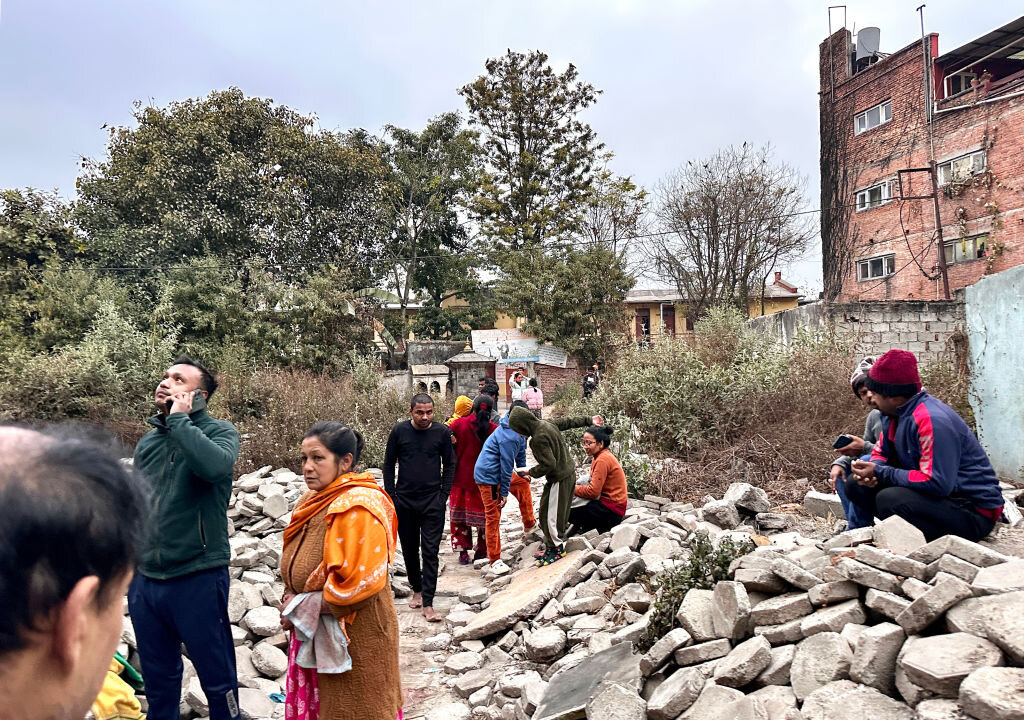‘Tibet has been ’liberated‘ for over 70 years—why are the houses still in such poor condition?’ one netizen asked.
Violent shaking woke Qi Hao up at 9:05 a.m. on Jan. 7 at a hotel in southwest Shigatse, China’s Tibet Autonomous Region. It was still early, just before sunrise, and most people were still in bed.
Qi instinctively rushed to flee the building.
“All the [loose] objects in the hotel were falling, and the shaking was unbelievably strong. I was terrified as I ran down the stairs, shivering with cold and fear,” he told the Chinese edition of The Epoch Times.
Temperatures were around 5 degrees Fahrenheit or minus 15 degrees Celsius. Like Qi, people did not have time to dress warmly before rushing outdoors. Many stood in the street in their underwear, and some Tibetan residents were naked, Qi recalled.
Later, he learned that a powerful earthquake had just struck the area.
China recorded the magnitude at 6.8, while the United States Geological Survey measured it at 7.1, which is almost three times stronger in terms of energy released. As of Jan. 10, China reported more than 1,600 aftershocks up to magnitude 4.4 in strength.
Due to extensive road damage, only emergency and government vehicles were allowed to pass through affected areas. Qi was in the area for a business trip. Since he couldn’t return home immediately, he and about 20 others decided to team up to help victims in the hardest-hit regions.
They loaded two vehicles with supplies, including instant noodles, and headed for Chamco Township, one of the most severely impacted areas. Qi described the scene as deeply tragic there—most of the houses had been reduced to rubble, and outside the local government office alone, he saw 18 bodies gathered together.
Volunteers from other regions also visited the quake-hit area to help with rescue efforts. Duo Ji (pseudonym) is one of them. “This is no ordinary earthquake. Thousands of houses have collapsed, and in some households, only one person has survived,” he told NTD, a sister media of The Epoch Times.
Qi also witnessed victims with bleeding heads and people carrying injured individuals out of buildings. He said that the scale of destruction in the affected areas was exacerbated by poor-quality housing. In rural areas, housing is often built with brick with no steel reinforcement.
“The villagers live in poverty, and the relief supplies haven’t arrived yet,” he said during his interview on Jan. 7, expressing deep concern for those enduring the cold without adequate clothing or shelter.
The official death toll was initially reported at 126 and hasn’t been updated since. As of Jan. 11, Chinese state-owned media cited 388 injuries based on data collected from local medical institutions.
The epicenter, Dingri County of Shigatse Prefecture in southwestern Tibet, is near the Nepal border and on the pathway to the North Base camp for adventurers before they climb Mount Everest.
The earthquake affected about 61,500 people, according to the local authorities. They said the quake collapsed at least 3,612 buildings and reported having relocated 46,500 people as of Jan. 8, and built over 1,000 temporary housing for Dingri County residents as of Jan. 11.
The area’s average altitude is over 4,300 meters or 14,108 feet. Nighttime temperatures have recently dropped below 14 degrees Fahrenheit or minus 10 degrees Celsius. The number of people missing due to the natural disaster is unknown. Given the region’s harsh winter conditions, hope for their survival is fading.
The earthquake also struck Lhatse County, 42 miles from the epicenter.
A county resident told NTD that his village has over 100 families, and almost all the houses have collapsed.
“We’re now sleeping in open areas. It’s impossible to fall asleep in such freezing temperatures,” the resident said. “Many are staying in cars.”
On the day of the earthquake, local tourism officials quickly closed the North Base Camp until further notice.
For decades, the Chinese regime has been touting the success of its developments—centered on infrastructure and tourism—in the Tibet Autonomous Region. The latest official data reported the 2023 gross domestic product for the region at 240 billion yuan ($33 billion), which is 60,000 yuan ($8,000) per capita—a 26 percent growth from 2021.
To some Chinese, the aftermath of the earthquake showed them a picture that was inconsistent with China’s official development stories.
In the commentary section of online posts pleading for disaster relief help, some online users questioned the Chinese regime’s long-standing claim of “providing extensive support for the development of Tibet.”
One user, commenting on a video about the Dingri County earthquake, asked, “Tibet has been ‘liberated’ for over 70 years—why are the houses still in such poor condition? Where has the funding for Tibet gone?” Another user remarked, “I always thought Tibetans were rich, but this earthquake has shown us the reality of Tibet.”
Shigatse is one of Tibet’s holy cities and houses the Panchen Lama, one of the most prominent figures in Tibetan Buddhism, second only to the Dalai Lama.
The Dalai Lama, who lives in exile in India, said he was “deeply saddened” upon learning of the earthquake. On Jan. 9, he offered prayers for the victims alongside dozens of his monks, which
Chinese Foreign Ministry spokesperson Guo Jiakun criticized the gesture as a political maneuver with “separatist” intentions.

